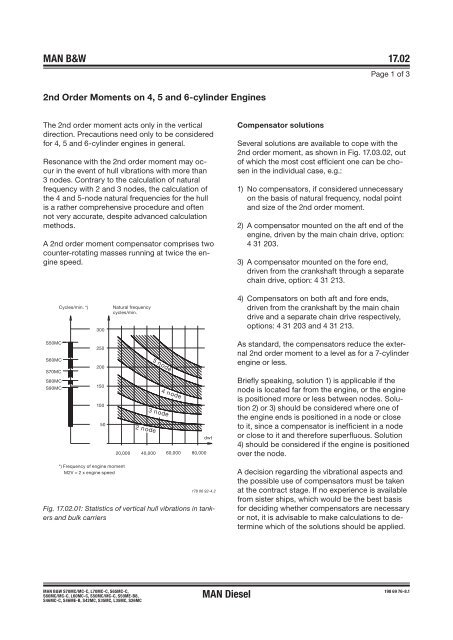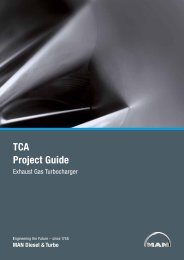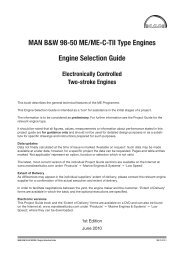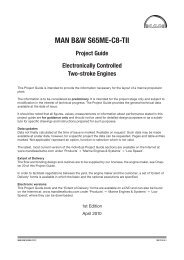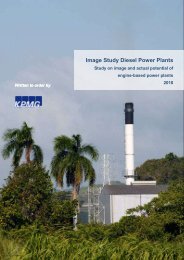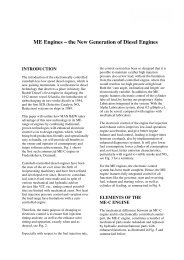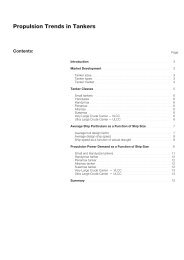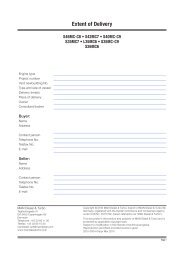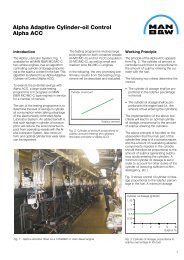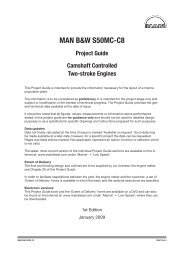This section is available on request - MAN Diesel & Turbo
This section is available on request - MAN Diesel & Turbo
This section is available on request - MAN Diesel & Turbo
You also want an ePaper? Increase the reach of your titles
YUMPU automatically turns print PDFs into web optimized ePapers that Google loves.
<strong>MAN</strong> B&W 17.02<br />
2nd Order Moments <strong>on</strong> 4, 5 and 6-cylinder Engines<br />
The 2nd order moment acts <strong>on</strong>ly in the vertical<br />
directi<strong>on</strong>. Precauti<strong>on</strong>s need <strong>on</strong>ly to be c<strong>on</strong>sidered<br />
for 4, 5 and 6-cylinder engines in general.<br />
Res<strong>on</strong>ance with the 2nd order moment may occur<br />
in the event of hull vibrati<strong>on</strong>s with more than<br />
3 nodes. C<strong>on</strong>trary to the calculati<strong>on</strong> of natural<br />
frequency with 2 and 3 nodes, the calculati<strong>on</strong> of<br />
the 4 and 5-node natural frequencies for the hull<br />
<str<strong>on</strong>g>is</str<strong>on</strong>g> a rather comprehensive procedure and often<br />
not very accurate, despite advanced calculati<strong>on</strong><br />
methods.<br />
A 2nd order moment compensator compr<str<strong>on</strong>g>is</str<strong>on</strong>g>es two<br />
counter�rotating masses running at twice the engine<br />
speed.<br />
S50MC<br />
S60MC<br />
S70MC<br />
S80MC<br />
S90MC<br />
Cycles/min. *)<br />
300<br />
250<br />
200<br />
150<br />
100<br />
50<br />
*) Frequency of engine moment<br />
M2V = 2 x engine speed<br />
Natural frequency<br />
cycles/min.<br />
<strong>MAN</strong> B&W S70MC/MC-C, L70MC-C, S65MC-C,<br />
S60MC/MC-C, L60MC-C, S50MC/MC-C, S50ME-B8,<br />
S46MC-C, S46ME-B, S42MC, S35MC, L35MC, S26MC<br />
2 node<br />
5 node<br />
3 node<br />
4 node<br />
20,000 40,000 60,000<br />
80,000<br />
dwt<br />
178 06 92�4.2<br />
Fig. 17.02.01: Stat<str<strong>on</strong>g>is</str<strong>on</strong>g>tics of vertical hull vibrati<strong>on</strong>s in tankers<br />
and bulk carriers<br />
<strong>MAN</strong> <strong>Diesel</strong><br />
Compensator soluti<strong>on</strong>s<br />
Page 1 of 3<br />
Several soluti<strong>on</strong>s are <str<strong>on</strong>g>available</str<strong>on</strong>g> to cope with the<br />
2nd order moment, as shown in Fig. 17.03.02, out<br />
of which the most cost efficient <strong>on</strong>e can be chosen<br />
in the individual case, e.g.:<br />
1) No compensators, if c<strong>on</strong>sidered unnecessary<br />
<strong>on</strong> the bas<str<strong>on</strong>g>is</str<strong>on</strong>g> of natural frequency, nodal point<br />
and size of the 2nd order moment.<br />
2) A compensator mounted <strong>on</strong> the aft end of the<br />
engine, driven by the main chain drive, opti<strong>on</strong>:<br />
4 31 203.<br />
3) A compensator mounted <strong>on</strong> the fore end,<br />
driven from the crankshaft through a separate<br />
chain drive, opti<strong>on</strong>: 4 31 213.<br />
4) Compensators <strong>on</strong> both aft and fore ends,<br />
driven from the crankshaft by the main chain<br />
drive and a separate chain drive respectively,<br />
opti<strong>on</strong>s: 4 31 203 and 4 31 213.<br />
As standard, the compensators reduce the external<br />
2nd order moment to a level as for a 7-cylinder<br />
engine or less.<br />
Briefly speaking, soluti<strong>on</strong> 1) <str<strong>on</strong>g>is</str<strong>on</strong>g> applicable if the<br />
node <str<strong>on</strong>g>is</str<strong>on</strong>g> located far from the engine, or the engine<br />
<str<strong>on</strong>g>is</str<strong>on</strong>g> positi<strong>on</strong>ed more or less between nodes. Soluti<strong>on</strong><br />
2) or 3) should be c<strong>on</strong>sidered where <strong>on</strong>e of<br />
the engine ends <str<strong>on</strong>g>is</str<strong>on</strong>g> positi<strong>on</strong>ed in a node or close<br />
to it, since a compensator <str<strong>on</strong>g>is</str<strong>on</strong>g> inefficient in a node<br />
or close to it and therefore superfluous. Soluti<strong>on</strong><br />
4) should be c<strong>on</strong>sidered if the engine <str<strong>on</strong>g>is</str<strong>on</strong>g> positi<strong>on</strong>ed<br />
over the node.<br />
A dec<str<strong>on</strong>g>is</str<strong>on</strong>g>i<strong>on</strong> regarding the vibrati<strong>on</strong>al aspects and<br />
the possible use of compensators must be taken<br />
at the c<strong>on</strong>tract stage. If no experience <str<strong>on</strong>g>is</str<strong>on</strong>g> <str<strong>on</strong>g>available</str<strong>on</strong>g><br />
from s<str<strong>on</strong>g>is</str<strong>on</strong>g>ter ships, which would be the best bas<str<strong>on</strong>g>is</str<strong>on</strong>g><br />
for deciding whether compensators are necessary<br />
or not, it <str<strong>on</strong>g>is</str<strong>on</strong>g> adv<str<strong>on</strong>g>is</str<strong>on</strong>g>able to make calculati<strong>on</strong>s to determine<br />
which of the soluti<strong>on</strong>s should be applied.<br />
198 69 76-8.1


